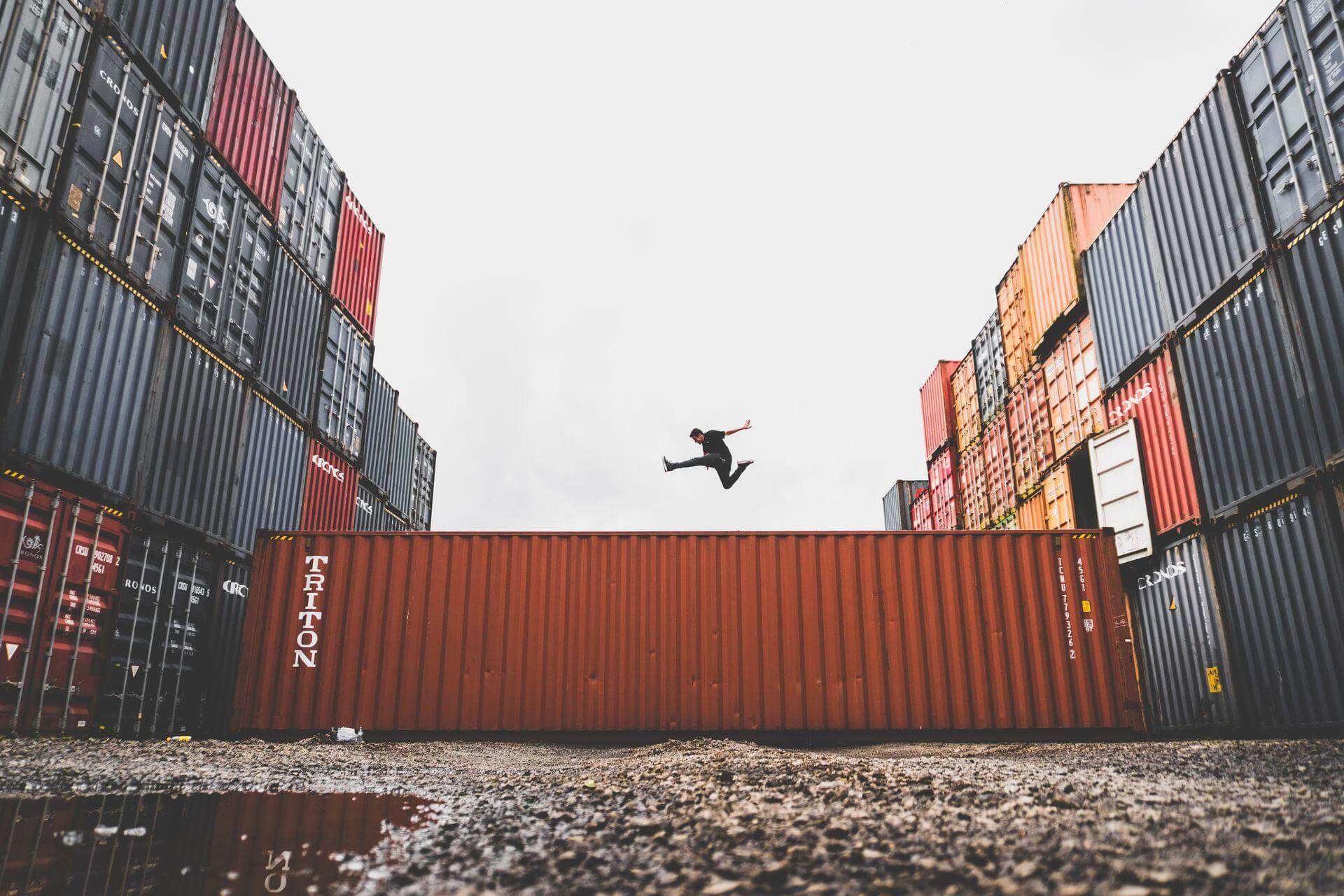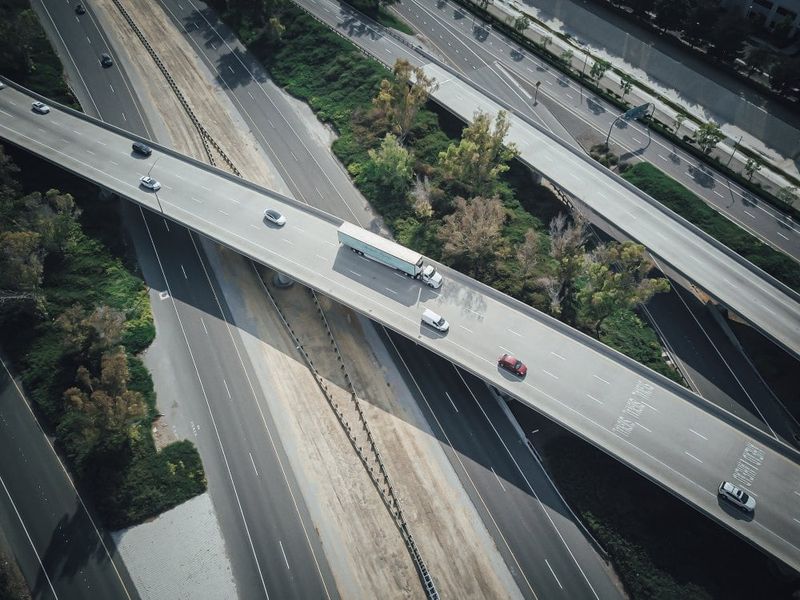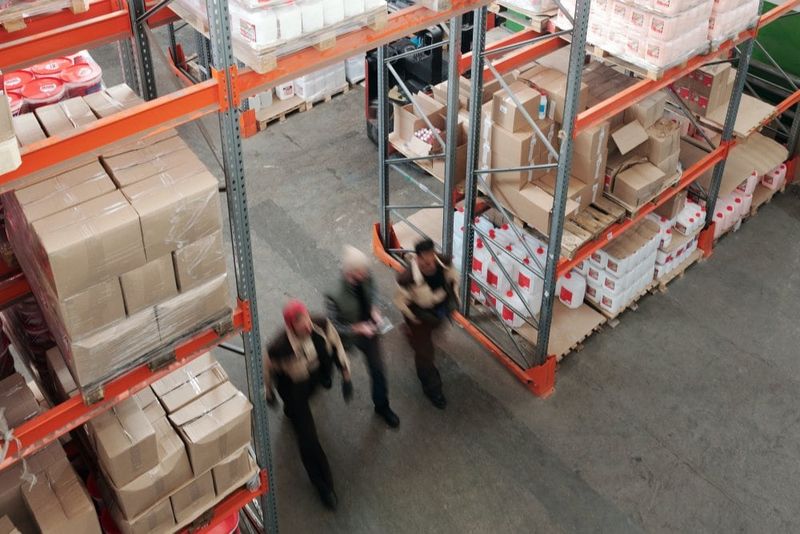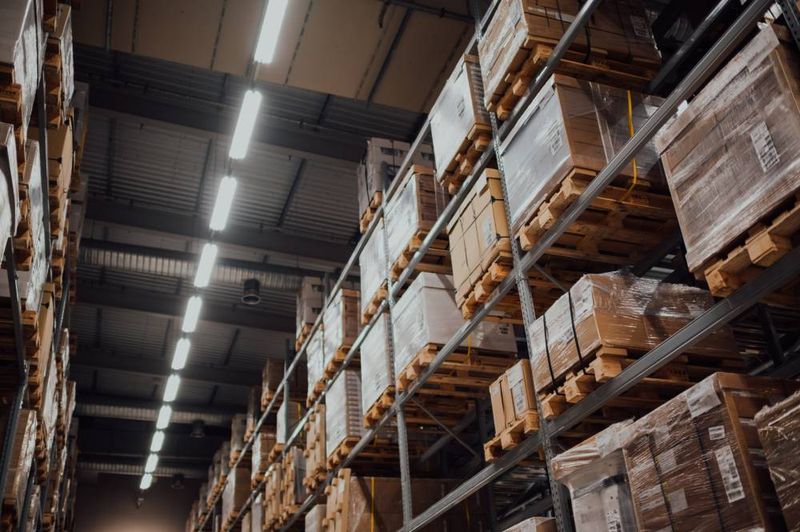This is the second article in our series for private label sellers. Click here for Amazon product research.
The right product has been found. Now it is important to find the right "partner" who can manufacture and deliver the product to you. We assume at this point that you will not manufacture the product yourself. If so, simply skip this chapter.
No matter which Seller you talk to, one sentence will always come up when it comes to the success factors in retail: "The profit is in purchasing". This is where you can do everything right or wrong. Therefore, please take the time for a detailed research, because you are looking for a partner with whom you will ideally work together on a long-term basis and who will manufacture even more products for you.
The following phases can be broadly distinguished in the context of supplier selection and import:
- Supplier research
- Supplier approach
- Evaluation of samples
- Price negotiation
- Selection of the logistics partner
- Import of the product
These points will be dealt with in more detail below.
Supplier research
The first step is to decide in which country you want to start your search. This depends mainly on your product. Some countries have specialised in the manufacture of certain products. However, this changes over the years. What is valid today may be outdated tomorrow. For example, the textile industry has "moved on" several times. Unfortunately most of them go to the countries with the lowest labour costs and - as a result - the worst working conditions.
When thinking of the many products, you will think of China first, and this thought is by no means wrong. However, when it comes to clothing, for example, it is worth taking a look at other Asian countries such as Vietnam, Bangladesh or Indonesia - the countries that follow China by a large margin in terms of the export value of their exported goods.
But it does not always have to be Asia. Now and then, "hidden champions" can also be found, for example, in the Eastern European market - or even in Germany. Therefore, do not commit yourself, but always keep your eyes and ears open. Disadvantages e.g. in the production chains can often be more than compensated by short delivery times, better quality or closer contact with the manufacturer.
China is by far the country with the largest export (2.2 trillion USD in 2013). Germany is ranked third after the USA with USD 1.5 trillion, although a large part of Germany's exports are in the B2B sector (e.g. machinery).
Another reason that is in favour of China is the country's now excellent infrastructure. Not only are there countless suppliers, but also other participants in the value-added chain: packaging manufacturers, companies that help with quality assurance, agents that help with supplier selection, and last but not least logistics companies.
Basically you have three possibilities to find suppliers:
- Direct research on the Internet
- Use of B2B platforms
- Visiting trade fairs at home and abroad
All three ways offer different advantages and disadvantages.
Doing your own research
If you know exactly which product you would like to purchase, a simple Google search is definitely worthwhile. Almost all manufacturers now have websites in English. This allows you to find suppliers that you would not have encountered through the other two channels. This can be a huge advantage. Because if you do what everyone does, you get the prize that everyone gets. And as you know, the profit is in purchasing. Even though platforms like Alibaba.com (see below) are very tempting because they make it very easy for you to find suitable manufacturers: Walk the extra mile and don't miss this step.
Use of B2B platforms
Meanwhile, there are many marketplaces that want to bring suppliers and buyers together. There is Alibaba.com (B2B) and Aliexpress.com (B2C). Both marketplaces are part of the Alibaba Group, a listed major corporation that operates various B2B and B2C platforms.
Alibaba.com is the largest and best known online marketplace today where suppliers and importers come together. The platform was founded in 1999. You can find products in over 40 categories. Buyers from over 190 different countries send an average of over 100,000 messages to existing or potential suppliers every day. And the trend is rising.
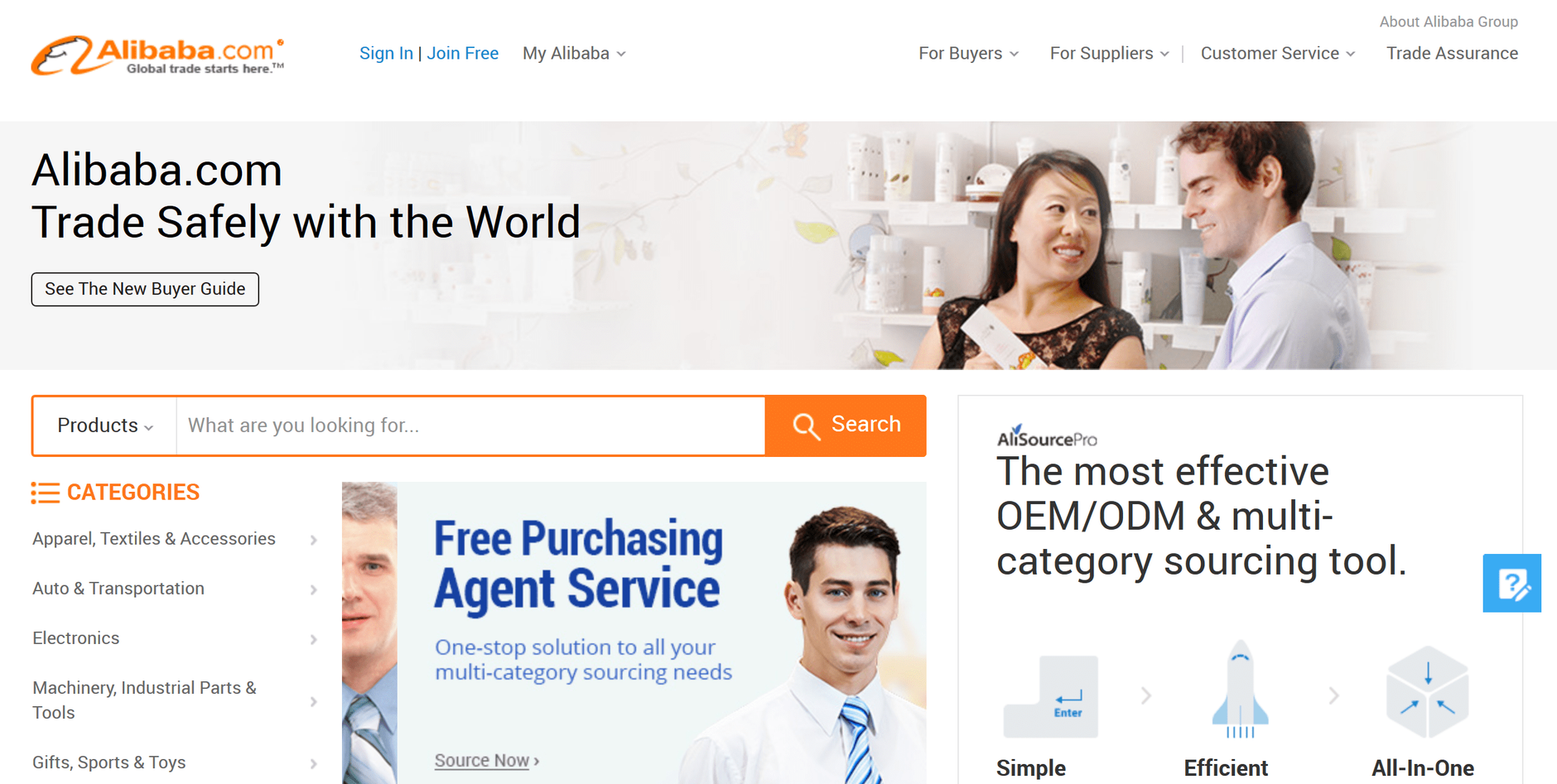
Global Sources
Another big platform in the Asian region is "Global Sources":
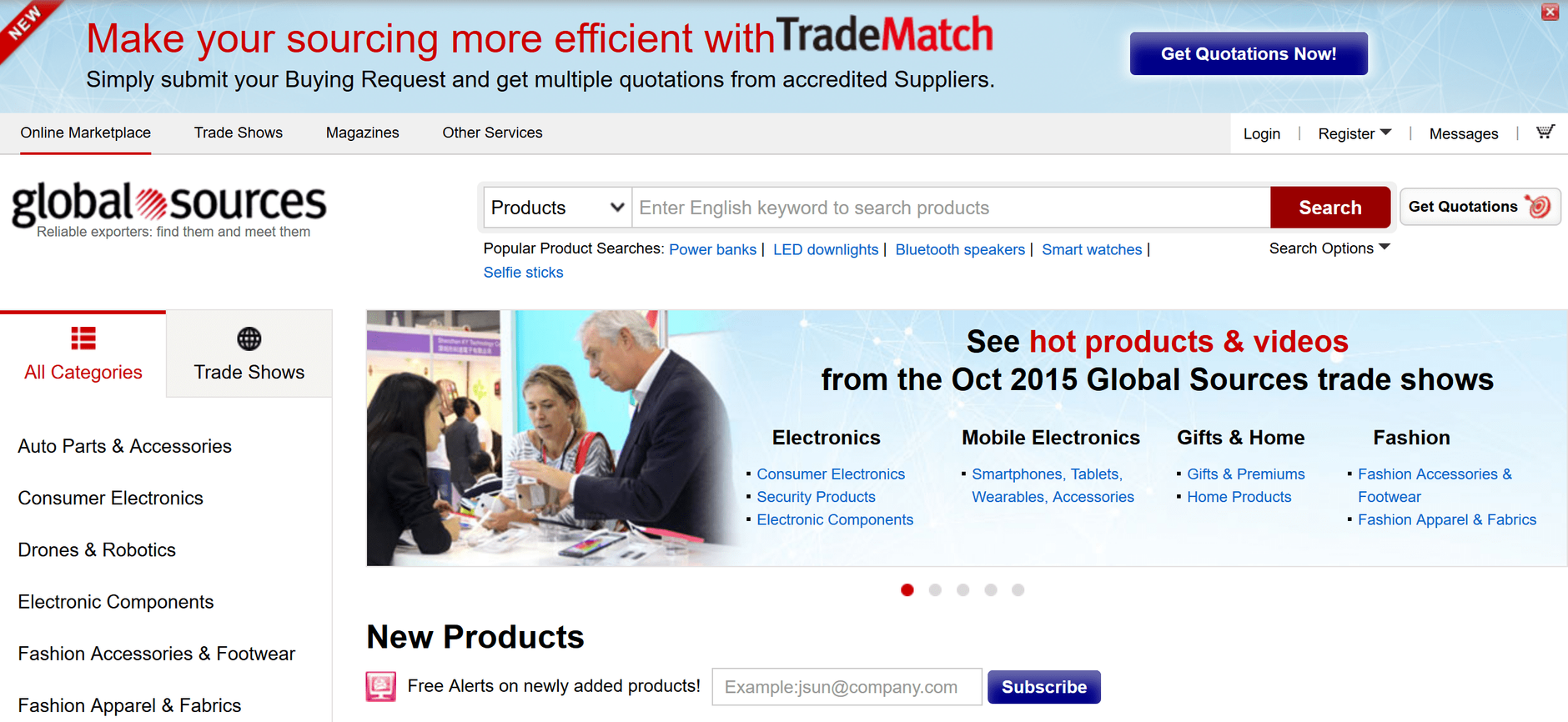
HKTDC
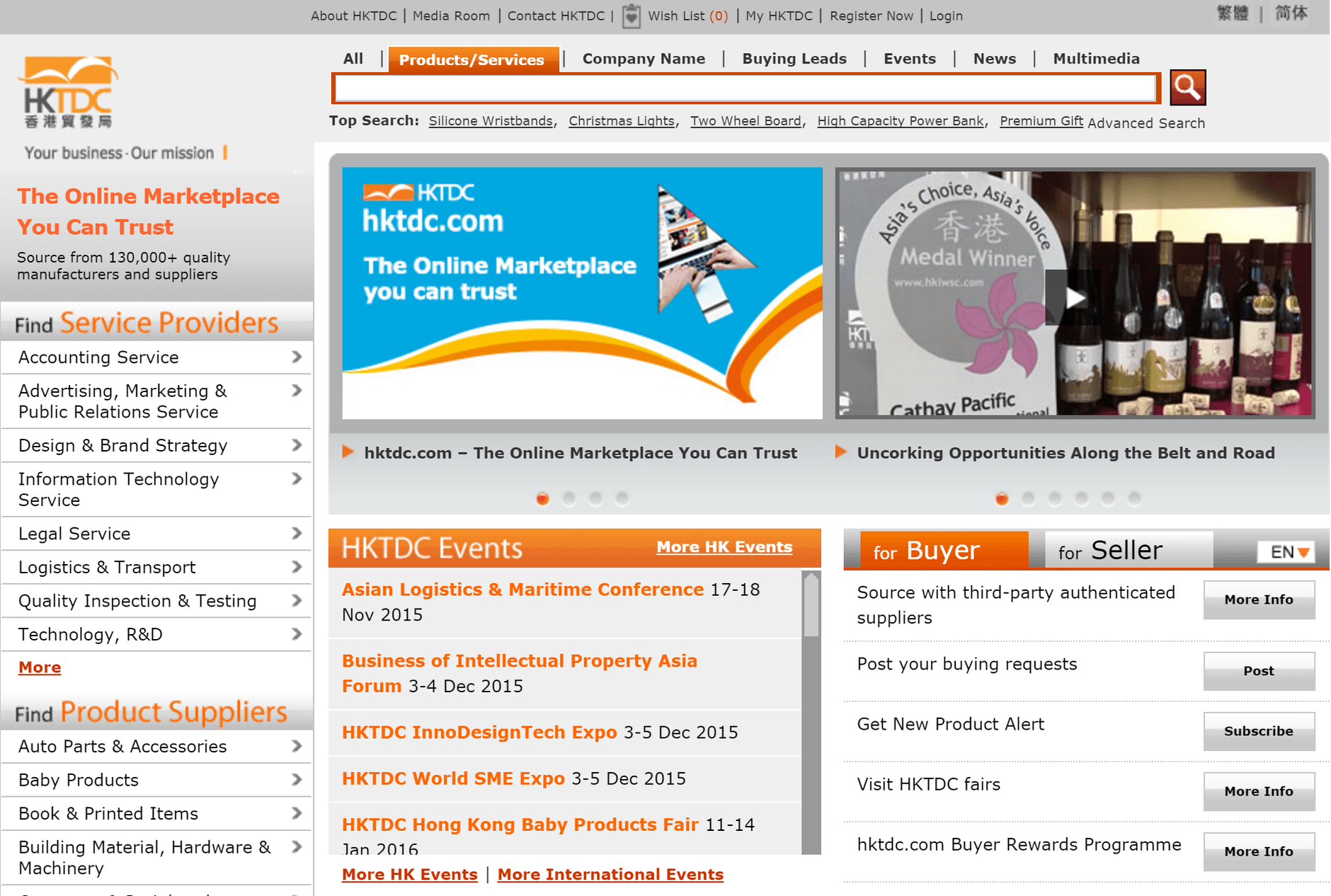
HKTDC is a platform for suppliers from Hong Kong, Taiwan and other countries.
TTTNET 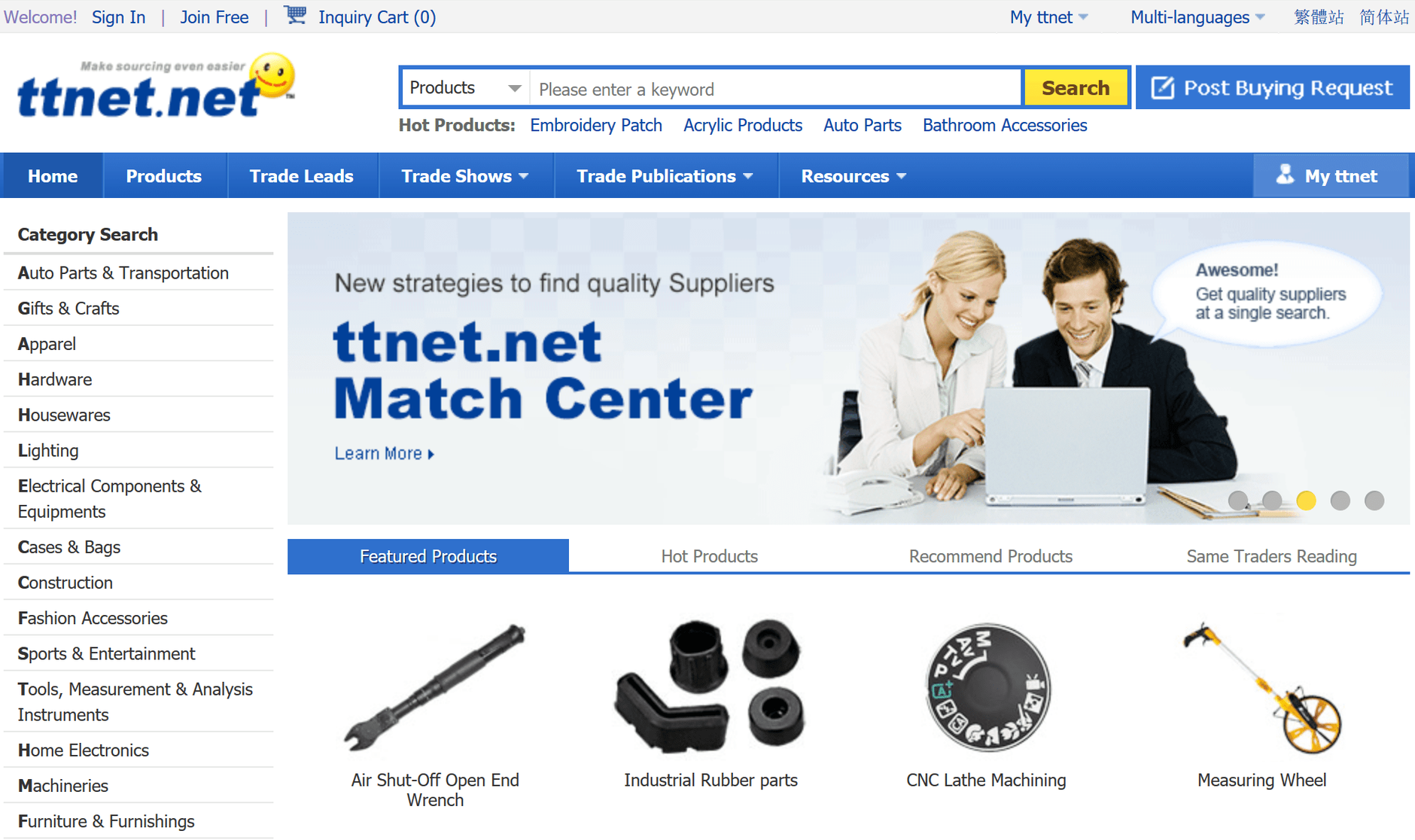
You will usually find your preferred supplier on Alibaba.com. Therefore, this marketplace will be discussed in more detail below. However, the findings can, by and large, be transferred to the other marketplaces. And at this point, I'd like to encourage you to look at other platforms first. Just because everyone looks at Alibaba.com first, you will probably get what everyone is buying.
Selection of suppliers on Alibaba.com
The biggest strengths of Alibaba.com are the sheer number of suppliers and the search functions offered to help you find your way through the masses. This is also necessary, because among the suppliers there are not only genuine manufacturers, but also middlemen and the odd fraudster.
As an importer, you usually want to buy from a genuine manufacturer and not from a middleman. Alibaba.com offers real added value here, because it offers different certifications:
Designation of the examination
**Who's gonna do it?
Scope of the test
| Name of the examination | Who conducts it? | Scope of the examination |
|---|---|---|
| A&V Check | Third parties | Little |
| Onsite Check | Alibaba themselves or a third party | Means |
| Assessed Supplier | Third parties (Bureau Veritas or TÜV Rheinland) | High |
An overview of what is checked in each case can be found on the homepage of Alibaba.com
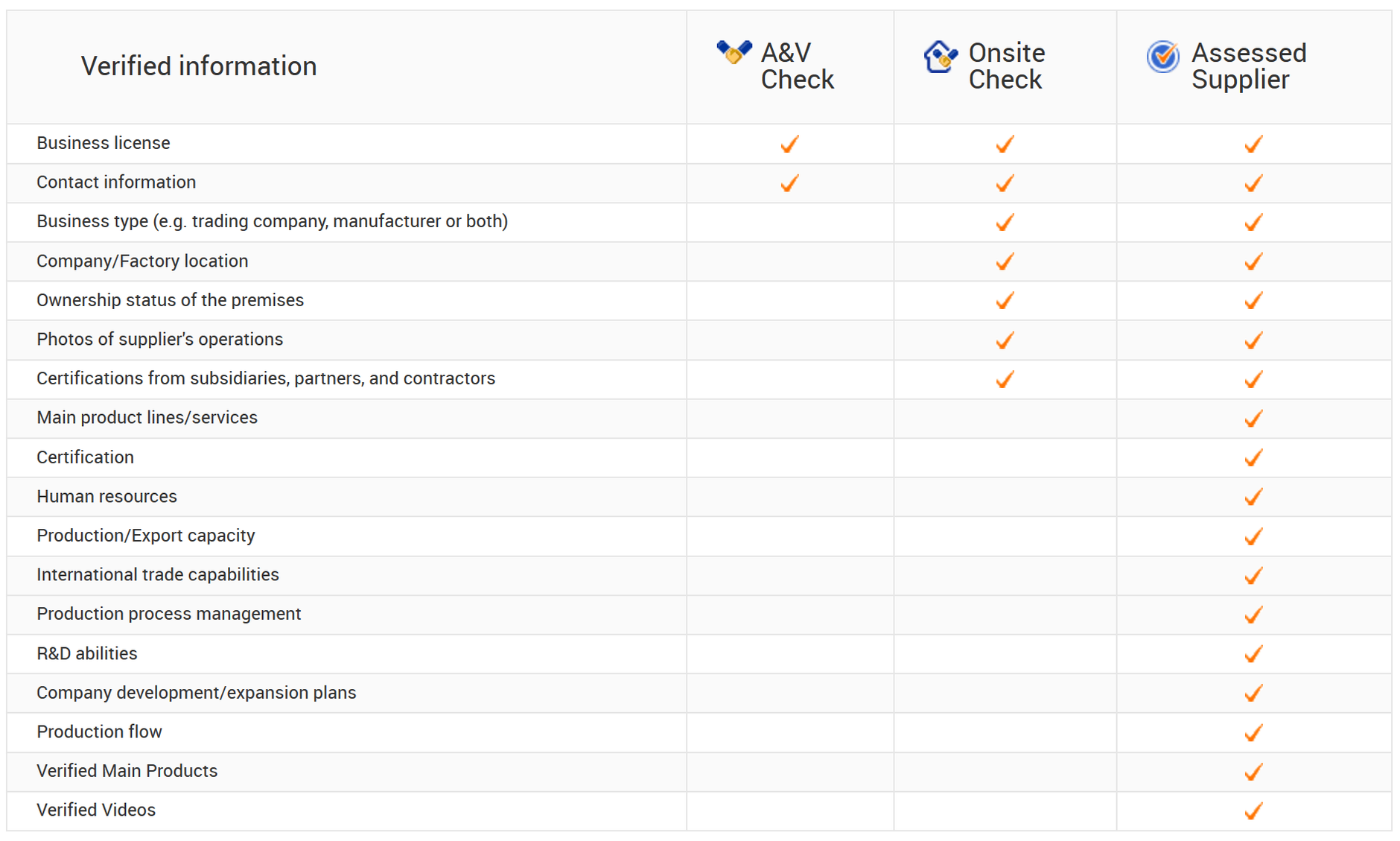
As you can see, the Assessed Supplier test is the most extensive. While the "Onsite Check" only checks photos, the "Assessed Supplier" carries out an on-site inspection. So if you want to be on the safe side, check the box "Assessed Supplier" in the supplier search. This significantly limits the choice of possible suppliers.
To further limit the selection of possible suppliers, you should pay attention to the following things, amongst other aspects:
- Price
- Minimum order quantity
- Payment options offered
The price is of course one of the most important, but you will often only get a price range here. And the price shown usually has little to do with the price negotiated later. Therefore, please regard the price of the product as a rough guide.
The Minimum Order Quantity ("Minimum Order Quantity" or "MOQ") indicates the minimum quantity you must purchase when placing an order. The quantity usually depends on the product price. Usually values between 3,000 and 5,000 euros are quoted, but don't let this put you off. Like the price, the minimum order quantity is negotiable. This is especially true for the first order, which is often referred to as a "test order".
The payment options are more interesting, because there are big differences - for buyers and sellers. The risk for the buyer is to pay money for goods that either do not arrive or are defective. If the buyer has no possibility to get his money back, the risk is high. But there are also risks for the seller: Does the buyer actually accept the ordered goods? Does the seller receive the agreed amount at the end? Both parties have conflicting interests, so do not focus on price alone in negotiations.
The following different payment methods have been established:
| English designation | Contents | Risk Buyer | Risk Seller |
|---|---|---|---|
| Escrow/Secure Payment | Payment processing via a trustee | low | low |
| Western Union | US American provider of worldwide cash transfer | high | low |
| PayPal | US American provider of online transactions | moderate | high |
| Letter of credit (L/C) | Documentary letter of credit (conditional promise of payment from the importer's bank) | low | low |
| Telegraphic Bank Transfer (TT) | Bank Transfer | depends | depends |
Table 2: Payment methods in the import business
- For "Escrow" payments, the transaction is handled through a trustee. For the Aliexpress platform, the Alibaba Group offers a separate service called "Secure Payment" via its Alipay platform. The money is first transferred by the buyer to an interim account of Alibaba at Citibank. Only when the buyer has received and inspected the goods, the payment will be released. The advantage for the seller is that he knows that the money is actually available and is no longer in the immediate reach of the buyer. If the latter wishes to reclaim his money, he cannot do so without giving reasons. In this case, a mediation process begins. As long as there is a mediation between buyer and seller, the money remains with the trustee.
- Western Union is a payment provider popular with migrants to send money home. You do not need a bank account for this. Stay away from this, especially if the seller demands high advance payments. There are better ways.
- PayPal is also a popular service in Germany for processing online payments, it offers the so-called "Buyer Protection" for the buyer. However, this is linked to certain conditions, which you should be aware of before you make a payment via PayPal. Therefore PayPal is not necessarily popular with suppliers. There is a residual risk that the buyer will reclaim his money without justification.
- Letter of credit (the Documental Letter of Credit) is a "directly enforceable, abstract, conditional" promise of payment by the buyer's bank, in which the bank undertakes to the supplier of a good to make payment upon presentation of certain commercial documents. "Abstract" in this context means that the bank's promise of payment is legally separate from the underlying transaction and stands independently alongside the purchase agreement. "Conditional" means that fulfilment of the promise to pay is subject to conditions which are always of a "documentary nature". The letter of credit is thus an instrument with which the interests of buyers and sellers of goods are balanced in foreign trade. This form of settlement gives the buyer the certainty that he only has to pay when the seller has delivered the ordered goods and has proven this by presenting proper documents. The seller receives the certainty that he will receive the proceeds of the sale after delivery of the goods and the presentation of proper documents to the advising (or, if permissible, another) bank. You'll notice that this sounds complex - and it is. In return it offers security for both sides. It is suitable for larger orders, as costs are also incurred by the bank. In any case, you should contact the foreign trade department of your local bank in advance, as they can help you with the processing.
- Telegraphic Bank Transfer (TT) is the traditional bank transfer with the difference that it involves a transfer abroad. The payment process is therefore relatively simple, most banks offer this as a separate feature in online banking. The risk is determined by what you arrange with the supplier. The more you transfer in advance, the higher is your own risk. The usual rate is 30% prepayment, the remainder after inspection and release of the goods. Prepayment requires that you trust the supplier, because theoretically the 30% can simply be gone. And asserting claims in China is a difficult undertaking. Please note that there are also costs for the bank transfer. These costs are usually covered by the buyer. Be sure to give the bank the correct instruction to avoid the seller receiving too little money. If the seller withholds the goods because of this minor matter and has to retransfer them, you will have to pay transaction costs again.
Identifying dubious suppliers
The import of goods is never free of risks. Here are a few signs that should give cause for scepticism towards the supplier:
- The supplier offers you branded goods at low prices (Apple, Samsung, etc.). Even if it sounds tempting: avoid such suppliers. If you import counterfeits and put them on the market, there is a risk of unpleasantness from many sides (customs, manufacturers, buyers, etc.).
- Suppliers insist on unsecure payment options (Western Union, MoneyGram, 100% prepayment).
- Substantially lower prices than the competition. Even if the profit lies in purchasing: Use your common sense and do not let greed guide you.
- Changing e-mail addresses or bank accounts. Clear sign: Don't touch me. If you transfer money to them, you can already say goodbye to your money. 5 You receive answers / offers from suppliers you have not requested. In this case, you may have come across a middleman who passes the leads on to various manufacturers. This does not necessarily have to be an alarm signal, but check the manufacturers you are contacted by carefully.
Visiting fairs
Another way to find suppliers is to visit trade fairs designed for this purpose. The largest of its kind is the "Canton Fair". The Canton-Fair ("Canton Import and Export Fair") is China's largest import and export goods fair in Canton, China with over 15,000 exhibitors. The city is also known as "Guangzhou".
The fair takes place twice a year (spring/autumn) and consists of three stages of five days each:
- Phase 1: Electronic products and electronic household appliances, machines, lighting products
- Phase 2: Products for household use, gifts, toys
- Phase 3: Textiles and clothing
A visit to the fair should be well planned in view of the sheer volume of exhibitors (and visitors). The advantage is that you can make personal contacts on the spot and gain an understanding of the goods. During a visit you may also come across goods that you had not thought of before. The Canton Fair is therefore always a good place to find new inspiration for products.
The fair also provides documents in German.
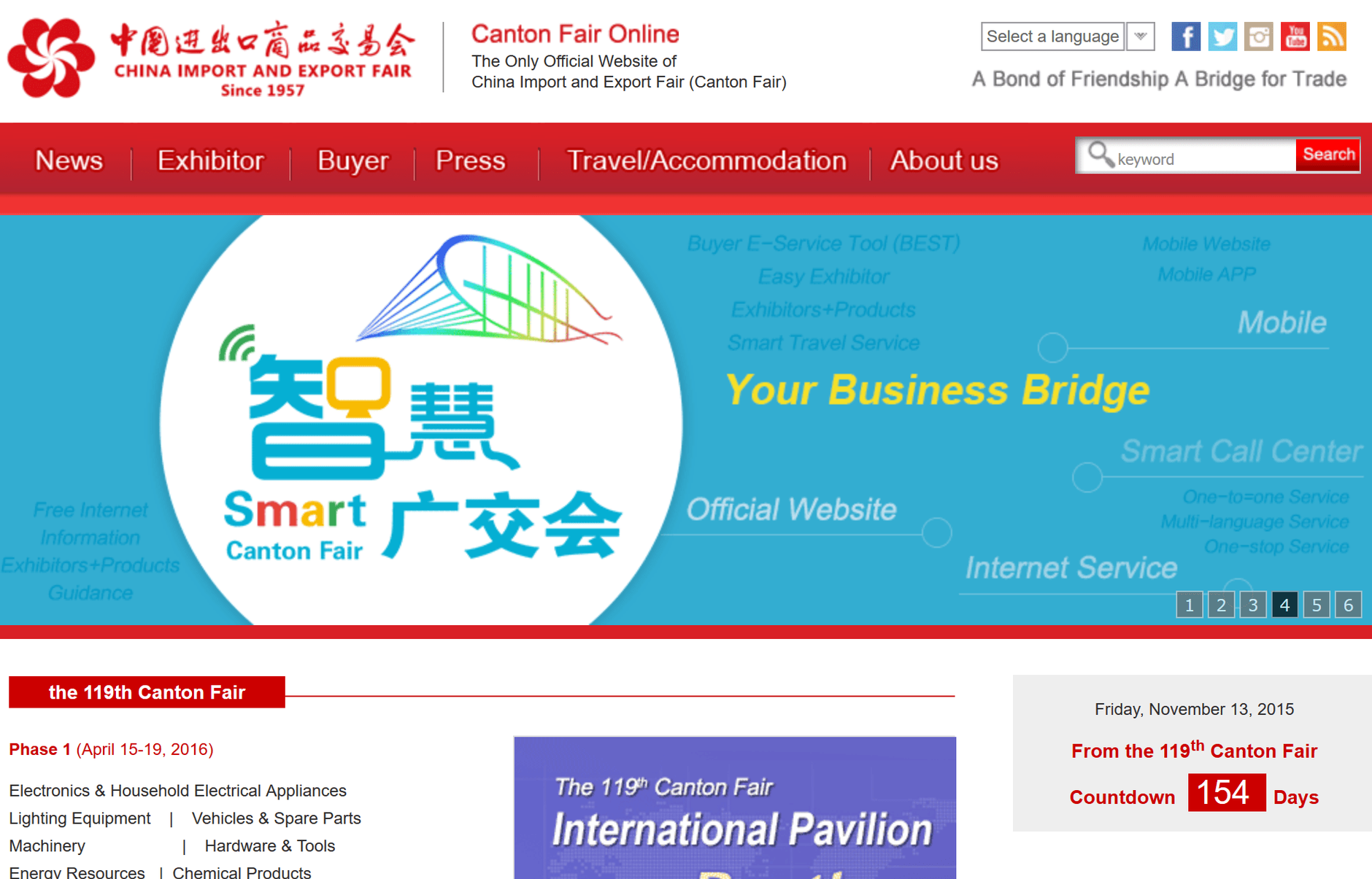
If you are planning to visit the trade fair, make sure you obtain a suitable visa in good time. As soon as you have registered for the fair, you will receive a confirmation of the fair ("invitation letter"). With this confirmation you can apply for an entry visa at the Chinese consulate.
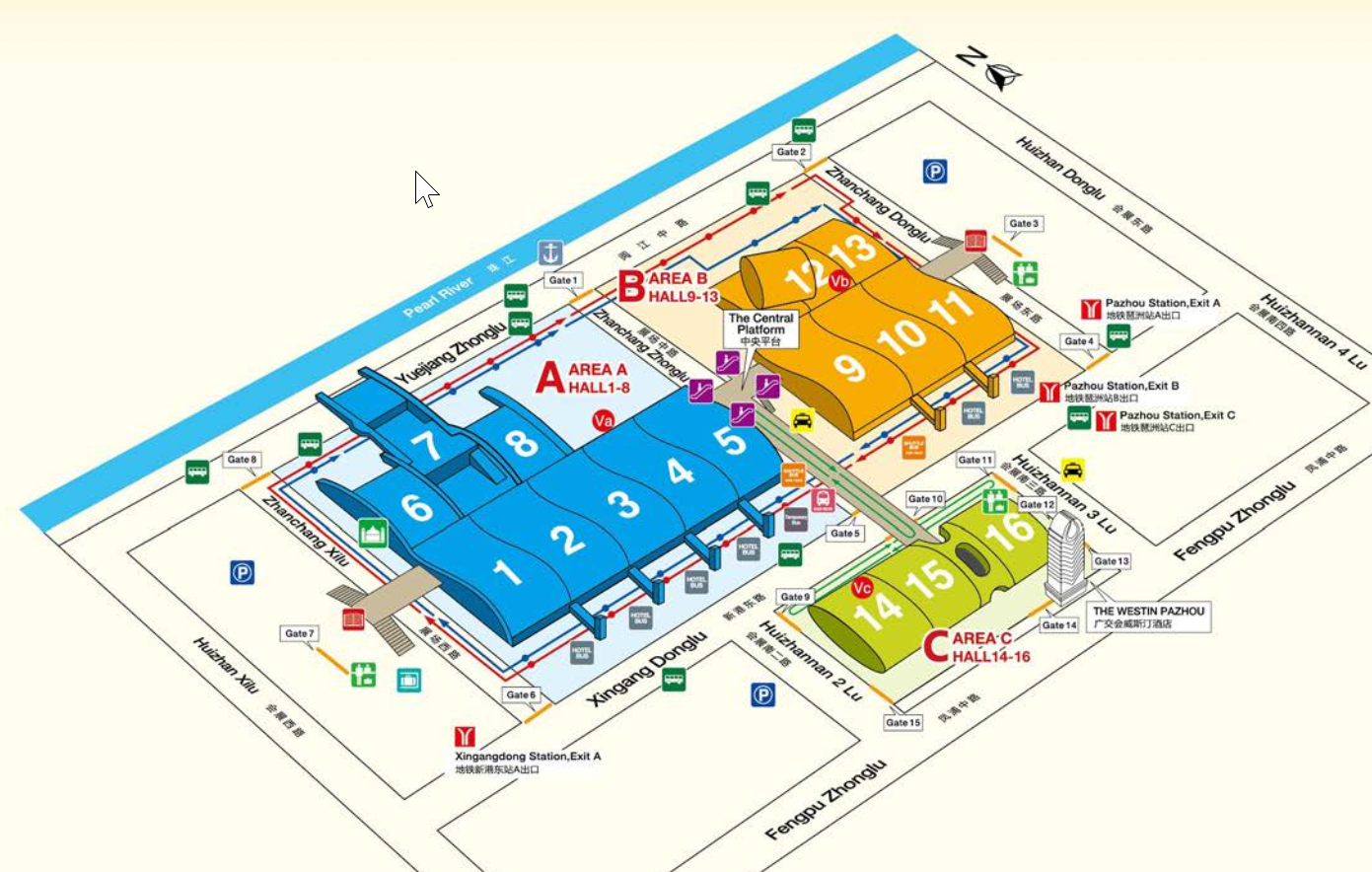
The Canton Fair has a total covered exhibition area of 338,000m².
Meaning of different certifications
Another way to assess the quality of a supplier is through their certifications. In the case of certification, a third-party company checks the supplier for compliance with certain standards. These standards can be of different nature. There are standards that define minimum requirements for business processes, working conditions or product characteristics, for example. Some of the better known standards will be briefly explained here:
ISO 9000-90004 (Management)
The ISO 9000 rules are intended to ensure quality control in the production of goods or the delivery of services. ISO 9000 clarifies some basic terms, whereas ISO 9001 requires proof of quality management in the context of development, design, production and assembly. This certification is of particular interest when selecting suppliers, since it is exactly about the important processes mentioned above.
ISO 14001 (Environment)
This standard contains specifications on various areas of environmental management, including eco-balances, environmental indicators and environmental performance evaluation. It can be applied to both manufacturing and service companies.
BSCI code of conduct (working conditions)
The Business Social Compliance Initiative (BSCI) is an association of retailers, importers and other participants who have defined a code of conduct for free and sustainable trade. In particular, requirements were defined for the working conditions of manufacturers. This is not a certification in the classical sense, but a voluntary commitment. By signing the BSCI Code of Conduct, companies commit themselves to recognise social criteria within their sphere of influence which form the basis of this Code of Conduct and to take appropriate measures for implementation and compliance within the framework of their corporate policy.
SA8000 (Working conditions)
SA8000 is an international Standard with the aim of improving working conditions for employees. Launched by Social Accountability International (SAI), an international non-governmental organisation (NGO) based in New York (US), the standard serves primarily transnational companies as a minimum requirement for social and labour standards. In contrast to the BSCI, compliance with the SA8000 standard is certified. The certification is carried out by accredited certifiers such as Bureau Veritas, Det Norske Veritas (DNV), DQS, Société Générale de Surveillance or the TÜV.
To obtain the certificate, a company must meet the following requirements:
- No child labour
- No forced labour
- Minimum standards in the field of health protection and occupational safety
- Trade unions allowed
- No discrimination
- No physical or psychological punishment
- Restrictions on working hours
- A wage level that is not too low
- Management requirements
RoHS (Ingredients)
Behind the RoHS Directive (RoHS = "Restriction of Hazardous Substances") is an EU directive that regulates the use and marketing of hazardous substances in electrical equipment and electronic components. The aim of the directive is to ban problematic components from electronic waste. This includes, among other things, replacing leaded soldering of electronic components with unleaded soldering, banning environmentally harmful flame inhibitors in cable insulations and promoting the introduction of corresponding substitute products that are as similar as possible. Furthermore, the electrical components and parts used must also be free of the problematic substances. So if you want to import or distribute such equipment within the EU, you are immediately affected by the directives, as you are obliged to ensure compliance.
The directive was renewed in 2011, replacing its predecessor. Since then, the new directive has also been referred to as "RoHS 2" in some places. You can read the exact wording of the directive on the following page:
http://eur-lex.europa.eu/LexUriServ/LexUriServ.do?uri=OJ:L:2011:174:0088:0110🇩🇪PDF
The categories affected include the following:
- Large and small electronic devices
- Computers, laptops, tablets
- Consumer electronics
- Light sources
- Electronic tools
- Devices containing semiconductors
Chinese importers are not required by local laws to produce RoHS conform products. It is therefore essential to pay attention to this guideline when selecting products. Alternatively, you can commission the company you have entrusted with quality control to carry out the RoHS inspection.
Supplier Approach
You have found several suppliers that you find appealing at first glance? Congratulations, you've already done a lot of work. Now it is a matter of making contact with the suppliers. Alibaba.com also offers easy ways to do this. Often a corresponding contact form is already integrated on the product detail page.
Before you start, make sure that you have your own professional website, because suppliers also look closely at who you do business with. Suppliers - like you - want to make as much turnover as possible with as few transactions as possible. You should therefore make a professional first impression right from the initial contact. This also includes the prospect of larger sales and the announcement that the first order is a test order. Suppliers know this game too, of course, but just play the game to avoid being rejected as a customer right from the start.
A possible first contact by e-mail could look like this:
Dear [Andy]
My name is [Mark Mustermann] and I am the responsible head buyer for [ABC GmbH].
We are a leading eCommerce retailer selling on different marketplaces in Germany, UK, and the US. Please find more details at: [http://www.abc-company.de\]
I am interested in your product [EXACT PRODUCT DESCRIPTION] which I found on Alibaba.com.
We are a leading eCommerce retailer selling on different marketplaces in Germany, UK, and the US. Please find more details at: [http://www.abc-company.de\]_
I am interested in your product [EXACT DESCRIPTION OF PRODUCT] which I found on Alibaba.com.
[LINK TO LISTING]
I would appreciate it very much if you could provide me with the following information:
- Price per unit for different order quantities
- Minimum order quantity
- Product certifications
- Production lead time
- Available colors
- Possibility for own branding (product/packaging)
- Available payment terms
If you have any questions please do not hesitate contacting me.
Kind regards
[Mark Mustermann]
Generally, you will need to adjust the approach depending on the product, as there are a few specifics to be considered for each product.
By the way, don't be surprised that most of the contact persons of the suppliers have English first names. This is what suppliers do to make it easier for potential buyers.
Also do not state that you are the owner/manager/owner of your company. This way you have the possibility to refer to your imaginary boss again later in the price negotiation in order to negotiate down one or the other percentage point.
Contact about a dozen possible suppliers using this method. In order to keep an overview, create an Excel spreadsheet, for example, which contains the name of the supplier, the contact person, the contact data and the requested information. This makes it easier to compare the offers.
The next step is to further narrow down the selection. You can request further information for this: please contact us:
- Company presentation including photos of the offered products, production facilities, number of employees etc.
- Proof of business registration, certificates
- Evidence from third party companies that audit the supplier
This may sound unnecessary from your point of view, but this is exactly how big buyers act, since the risk/the so-called compliance requirements are even higher for them. There are also products that are not allowed to contain certain substances. Please have this verified by appropriate certificates.
Also evaluate the communication. Is it fast and clear? Do suppliers take long to respond? Is it already complicated to get to business with them? Does the supplier answer with standard e-mails, does he not answer specific questions? All these aspects can be indications for the future business relationship. If you have doubts about the reliability of a supplier, look further. You will immediately notice when you have found a good supplier.
Evaluation of product samples
If you have a "short list" of possible suppliers, it is time to request samples. Do not order based on photos alone, even if you are in a hurry. Thanks to DHL, UPS, FedEx and Co., samples reach you faster than you think. Only when you hold your future product in your own hands will you know whether it really meets the requirements of future buyers.
In a later chapter we will talk a lot about positive feedbacks and reviews. The product plays the main role here. Therefore, do not buy anything that you are not 100% convinced of yourself.
The costs for samples and shipping are usually carried by the buyer. This is common, as some customers simply want to enjoy cheaper products. Suppliers protect themselves against this by doing so - and that is understandable. The cost of a product may therefore be higher than the stated price in order to deter these bargain hunters.
Samples are usually sent by air freight (sea freight takes too long). This may be expensive for express service providers, but it is worth it. Please note, however, that some categories of goods are restricted from shipment in airplanes. This is true e.g. for certain batteries, because some of them are self-igniting (planes have already burned out that way). If you are unsure about electronic items, for example, please clarify this in advance with the customer service of the respective courier service (e.g. DHL).
By the way, you can often charge the costs for the samples in a later bulk order. Simply ask the supplier about this when ordering a sample. If you don't, he won't tell you.
When ordering samples, you must ensure that you are not slowed down by customs. You should therefore ask your supplier to mark the invoice with the words "SAMPLES WITHOUT COMMERICAL VALUE". Maybe the supplier will do you a favour and give you a lower value of goods, which makes customs clearance cheaper. However, he should not describe the goods as "gift". Also, a too low value of goods, which does not match the product, makes customs sceptical.
Otherwise, you should make sure that you describe exactly what (product, colour, size, etc.) you want to receive and in what quantity. You should also not forget the correct delivery address.
Price negotiation
If you like the samples, it is time to enter into price negotiations with the supplier. Haggling over the price is part of it. And even if "the profit lies in purchasing", it is not about pushing the price below the supplier's pain threshold. This is where the spirit of partnership comes into play again: you are interested in a long-term business relationship - and that only works if both parties benefit from doing business with each other.
Your first order should be a small test order to see how the product is received by buyers. Since your order quantity for a test order is usually below the minimum order quantity specified by the supplier, your negotiating power is limited and you should respond to the price proposal of your seller.
However, you should negotiate the prices for larger order quantities even before the test order. Enter into negotiations by promising a concrete order at a price reduced by 15-20% and also ask for quantities for larger orders.
In this way, you can identify the price flexibility of the supplier. It also gives you an estimate of how much additional leeway you will have in your calculation once you have successfully developed a market. It is possible that your first "test order" does not yield a big profit, because you still have to invest a lot in marketing and advertising to build your reputation on Amazon. However, once this is done, you can usually sell larger quantities. In this case it is important to know how much leeway the supplier has in terms of pricing. You can also use the information to determine the optimal order quantity for you.
Of course you can also create an artificial competitive situation or exploit an existing one. If other suppliers have offered significantly lower prices, you should openly discuss this with the supplier.
Always ask for a price fixing period as well. Depending on how quickly you want to order or reorder, this should be at least 30 to 180 days. Don't let the supplier put you under pressure if he lets you know that the price may change next week. Since you usually approach several suppliers, you should have enough time to negotiate the exact offer with each supplier. The process can easily take up to three weeks, so the supplier should adhere to the offer for at least 30 days.
From here on it depends on your assessment and your personal negotiating skills. At a later date you can bring your imaginary boss into play, who has other ideas and see how the supplier reacts to them.
Product packaging
An important point that you should clarify with your supplier is the product packaging. There are requirements by Amazon, the legislator and yourself.
Amazon has defined "Packaging Guidelines", which you should follow to ensure that Amazon does not reject your items. Study them carefully, because depending on the type of product you may be subject to further regulations. Important regulations - among other - are:
- If a product consists of several individual parts, these must be packed together in one package/box
- Each parcel/bag requires a clearly legible, scanable barcode that identifies the product and ownership. A product is identified either by a UPC or EAN barcode or by a "Shipping through Amazon" label with an FNSKU barcode, which you receive through your Seller Central account.
- Each product should be clearly recognisable from the outside and should contain a product name.
- Sensitive products should be sufficiently well packed - this should also be in your own interest.
- Plastic bags may need to have a suffocation warning.
Additional guidelines apply - among others - to the following products:
- Liquids
- Granules and granulated material
- Sharp items
- Glass, ceramics, fragile articles
- Toys and plush toys
- Textiles
- Pressure and temperature sensitive items
- Products with best before date
- Erotic items
- Bundles/sets
- Jewellery
- Wine and other beverages
Quality assurance
Despite extensive supplier research, it is never possible to exclude all risks. However, in order to further minimize these, it is advisable, especially for larger order volumes, to commission external companies to look over the manufacturer's shoulder at various times. These companies call themselves "Inspection Services" and specialize in assisting importers with quality assurance. This inspection can take place at very different times, for example
- Supplier selection/screening: the factory is inspected on site and/or whether certain working conditions and standards are observed (Beispiel).
- Production monitoring: the production process is monitored in order to detect and eliminate errors at an early stage (example).
- Inspection of the finished goods: Before the goods are loaded and shipped, randomly selected samples are inspected with regard to predefined specifications (example).
- Supervision of the shipment: Before the goods are loaded by air or sea freight, an inspection is carried out to ensure, among other things, that the goods are properly packed, labelled and loaded and, of course, that they are complete (example).
As a result, the importer receives a detailed inspection report containing, for instance, photos of the company, the production processes, the goods and the containers.
It is important that it is agreed in advance with the inspector on site what he should pay attention to, at what point a deviation (e.g. from a sample) is a defect and what deviation can still be tolerated.
Prices vary depending on what is to be tested. An inspection of the factory is usually more complex than an inspection of the finished product. For the latter, depending on the inspector, the cost is around USD 200-300.
When selecting the company, it is important to ensure that it has experience with the products to be tested and is represented in the supplier's region. You should choose the company yourself and not listen to recommendations from the supplier.
You can find suitable providers either via Google or - who would've thought - on Alibaba.com:
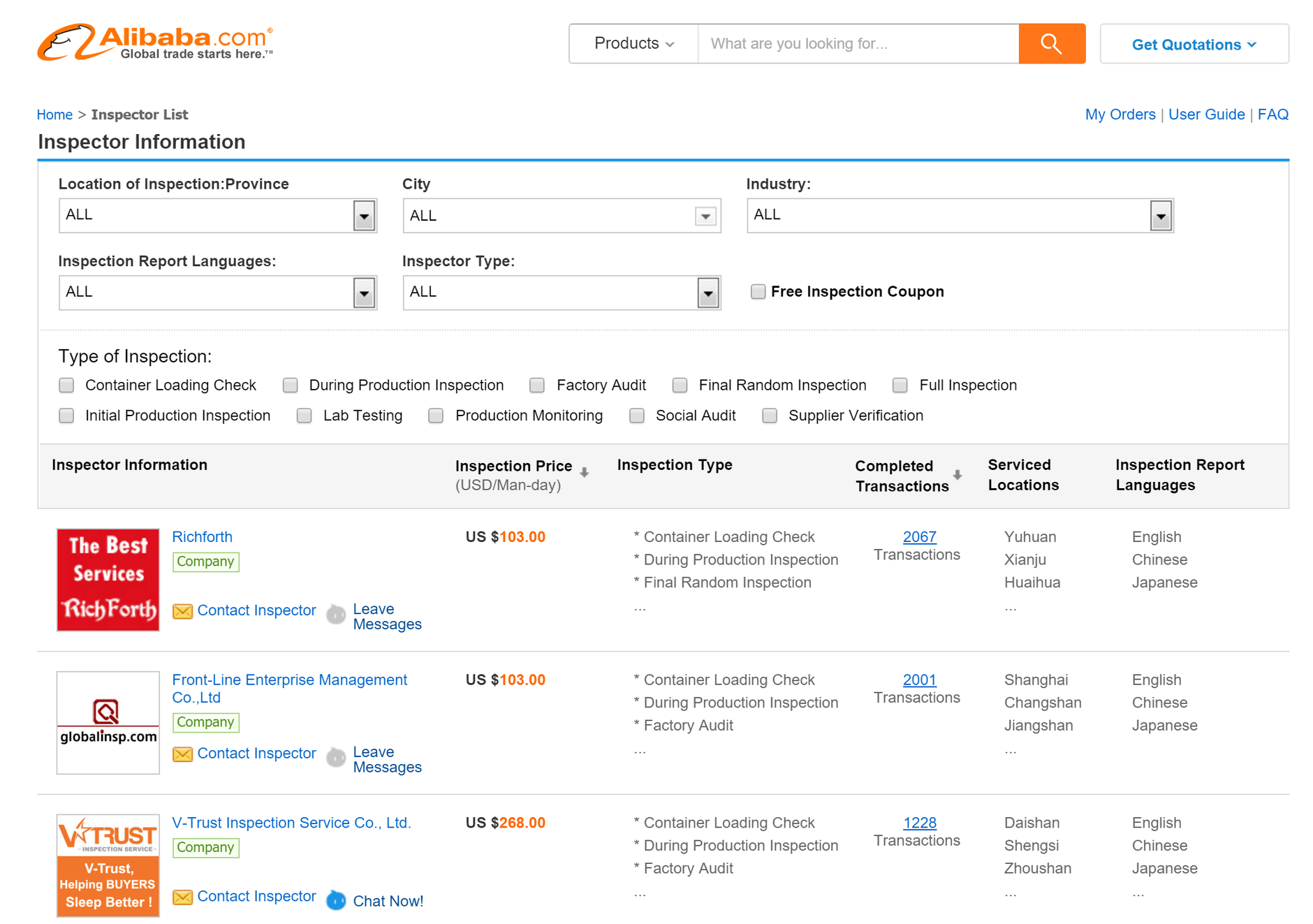
As we have already mentioned, it is always worth commissioning a project if the occurrence of a risk would result in an enormous financial loss. If it certainly doesn't make sense for a test order of 1,000 euros, then things will definitely look much more different for an order of more than 5,000 euros. But everyone must assess the risk for themselves.
An advantage is not only the inspection itself, but also the fact that the supplier knows that someone will be looking over his shoulder. In case of doubt, this alone will lead to the fact that he will have to put more effort into the production, as he does not want to be left with defective goods either.
Selecting the logistics partner
If the order is completed, the choice of a logistics partner comes next. The reason: the supplier usually sends your goods to the next port for the price indicated. In the world of foreign trade this is known as "FOB" ("Free On Board"). You as the buyer are then responsible for the remainder of the trip.
Therefore, you need a partner who will receive the goods on site, take care of the transport to Germany as well as customs clearance. If you do not have a partner at hand, ask the supplier for recommendations. Usually he has already delivered to Germany.
However, you should be aware of the exact services that the logistics provider offers. There are two main distinctions in this regard:
- Air and/or sea freight
- Container and/or partial load
Air freight vs. sea freight
Goods can reach Germany via two routes: by plane or by ship. Basically, this principle is to be applied: Cargo space in an airplane is expensive, but the plane is faster (5-7 days, even faster with Express). Cargo space in a ship is relatively cheap, but the ship is rather slow (4-6 weeks). It is not possible to make a broad statement about what is the better means of transport. This depends on the product and essentially on the size and weight. Large and/or heavy products are more suitable for transport by ship.
Whole containers and/or partial loads
Goods transported by sea are transported exclusively in containers. Some logistics companies only accept full containers (FCL="Full Container Load"), others also do "non-full" containers (LCL="Less Than Container Load").
If you have the goods shipped via FCL, you pay a fixed price per container, no matter how full it is. The containers are available in different sizes (20 feet and 40 feet). The default one is the 20 foot container.
If you send the goods as a partial load (LCL), you pay a price per cubic meter (CBM). The freight costs per unit tend to be higher with this form of loading than if you order a whole container. However, you usually have to order a large quantity if you want to fill a whole container. At the beginning of your seller career, you will therefore usually have your goods transported as partial loads.
Selection of possible suppliers/providers
There are many logistics companies. Often enough a Google search for "Import China Sea Freight" will get you a lot of results. Here you can find possible partner, which is specialised in importing from China:
Emons
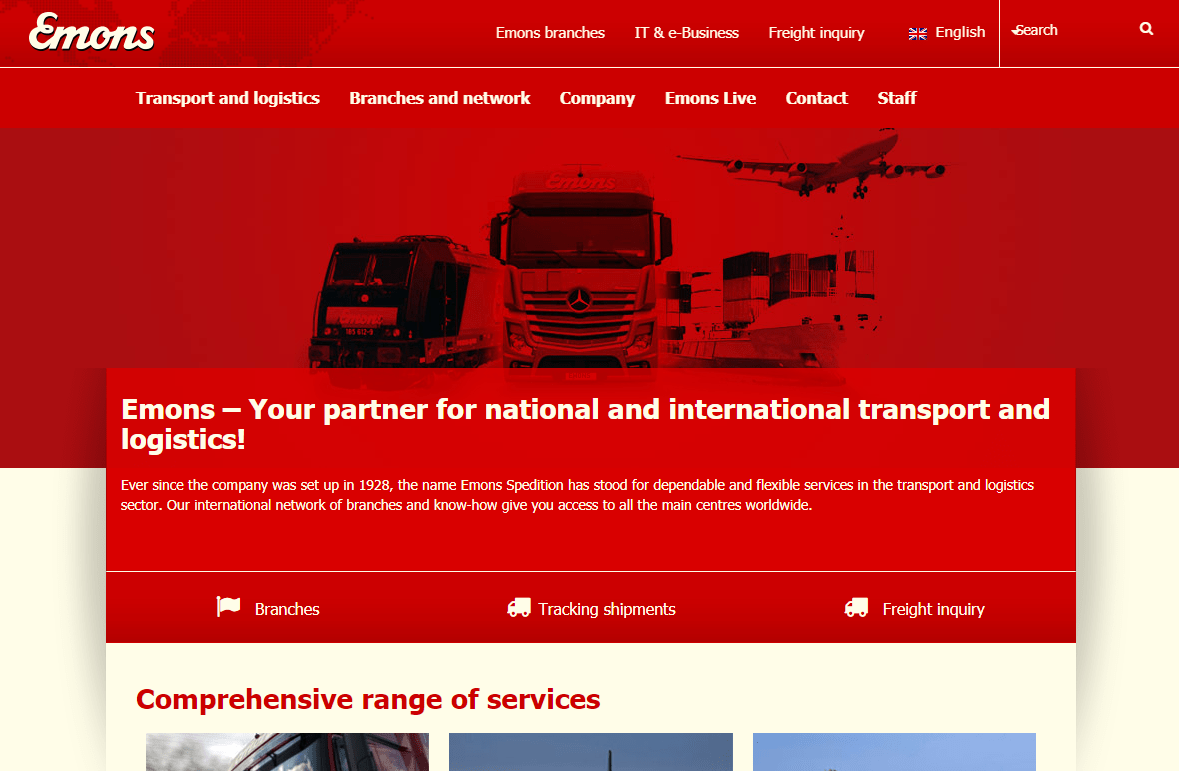
It is always worthwhile to contact logistics companies in your area. You will quickly appreciate a personal contact person.
However, the large logistics groups such as TOLL, Schenker, DHL or Kühne & Nagel are equally suitable. They do tend to be a little more expensive than some specialists, though, and especially as a small Seller you don't get to enjoy any of the attention you would normally get from a smaller logistics company.
More articles, that may interest you:
- Amazon Project Zero - Together Against Trademark Infringements
- Evaluate and Analyze Amazon Session and Conversion Data
- Amazon Product Opportunity Explorer: How to Identify Sales Opportunities
- Amazon Concessions Dashboard for Vendors: How to reduce concessions
- The "Item Comparison and Alternate Purchase Behavior Report" Explained in Detail
